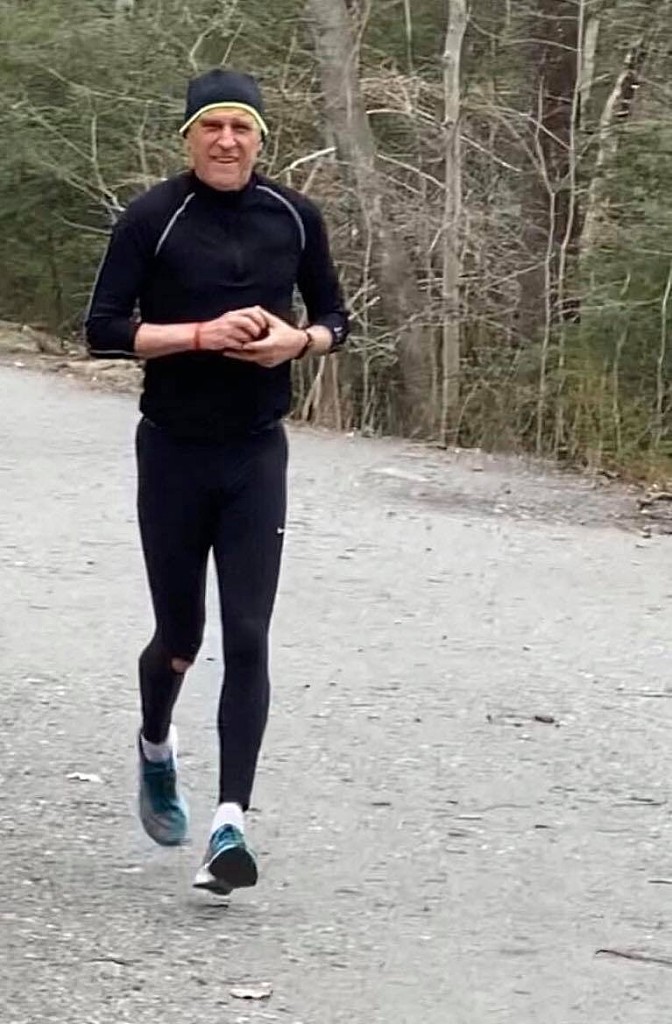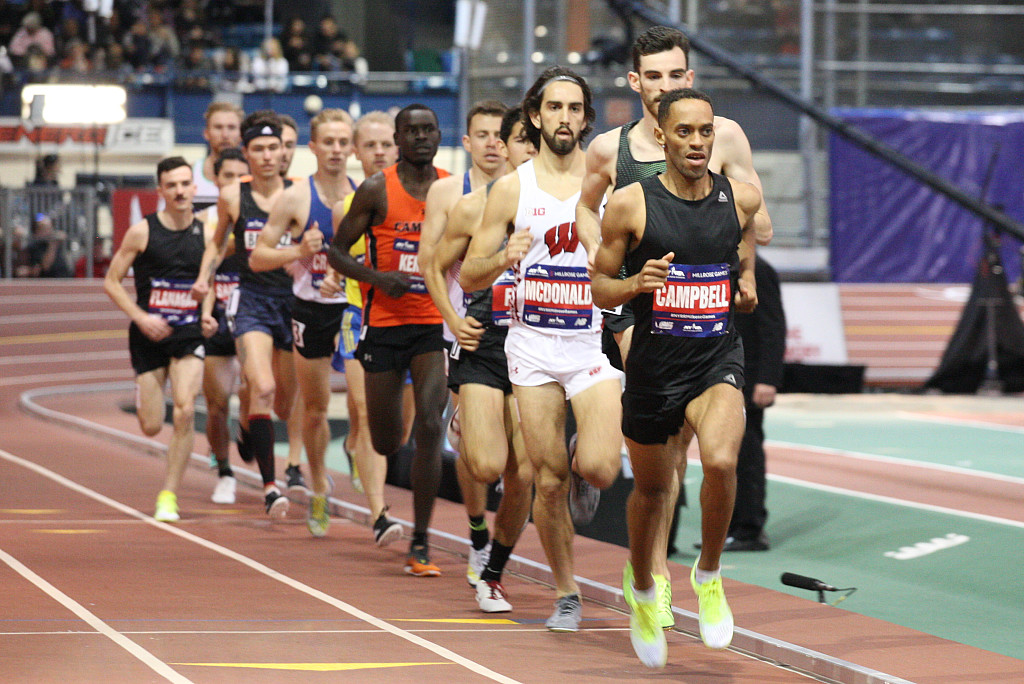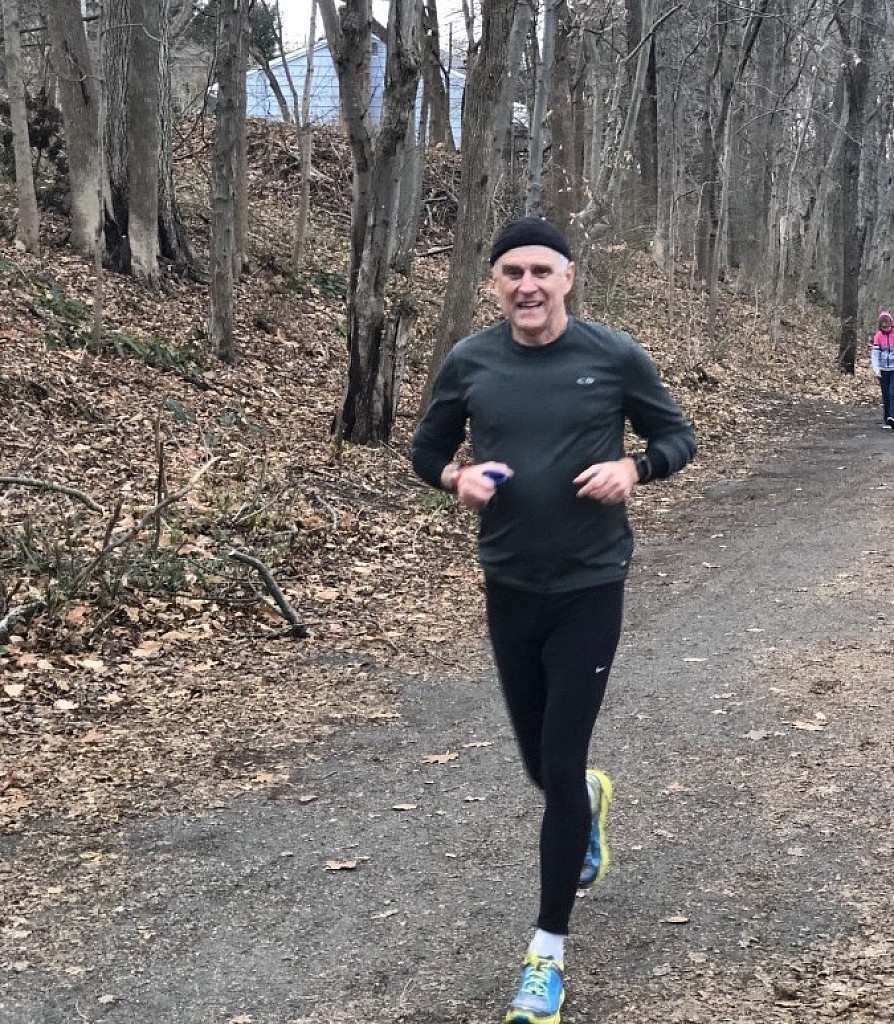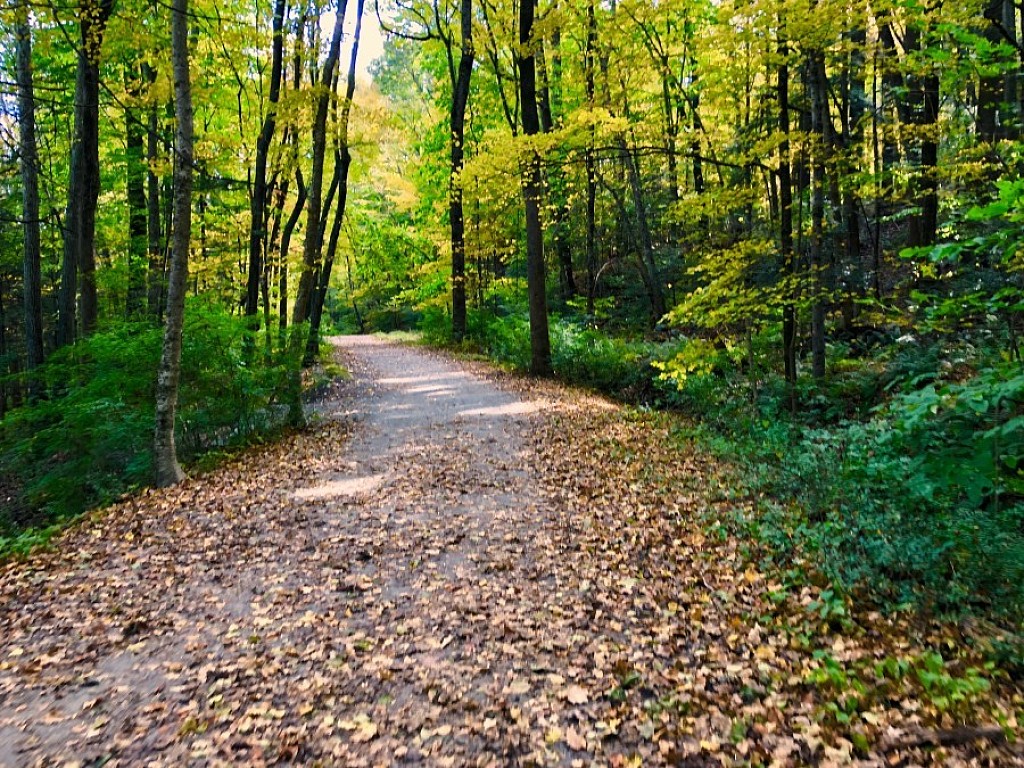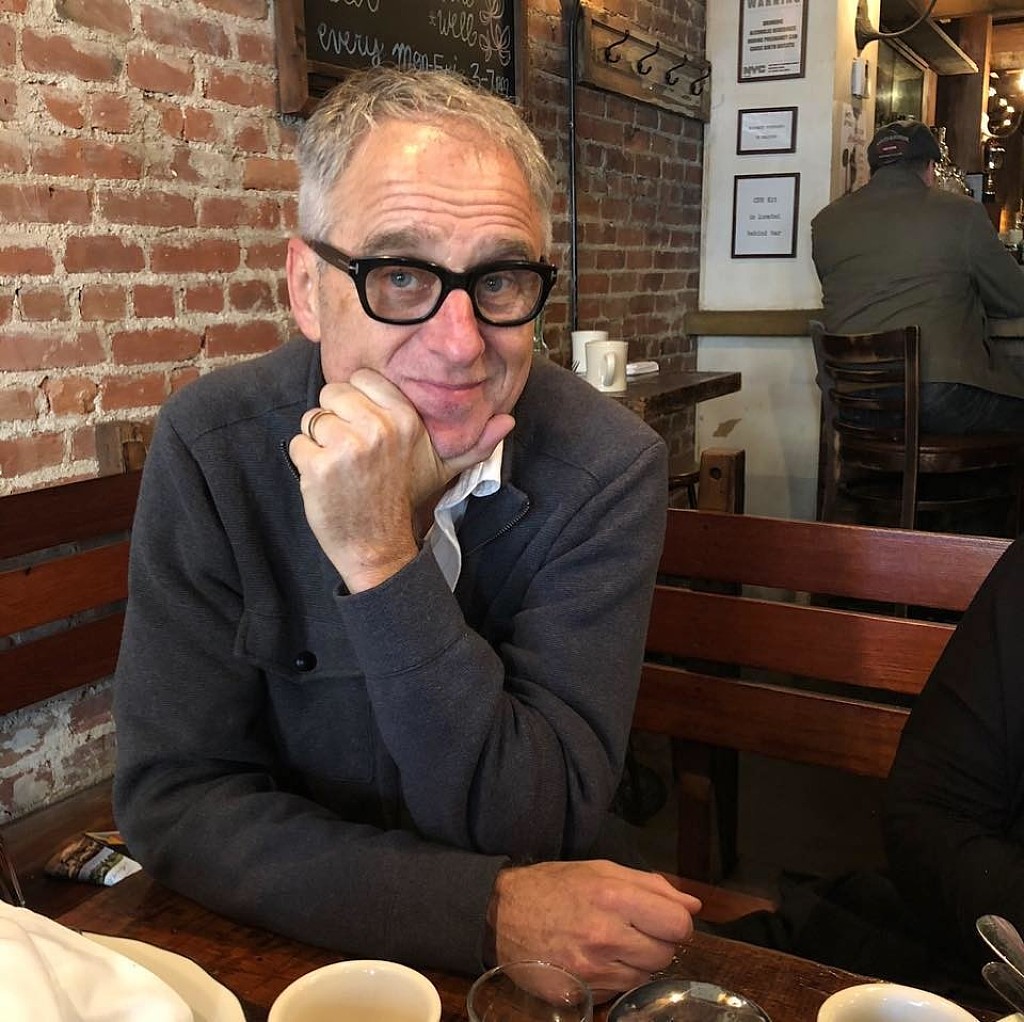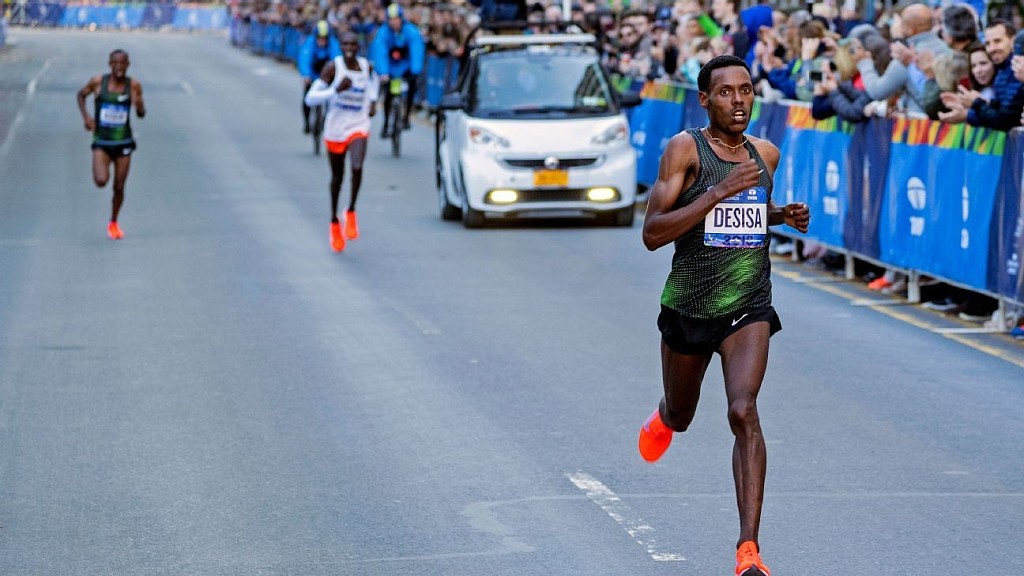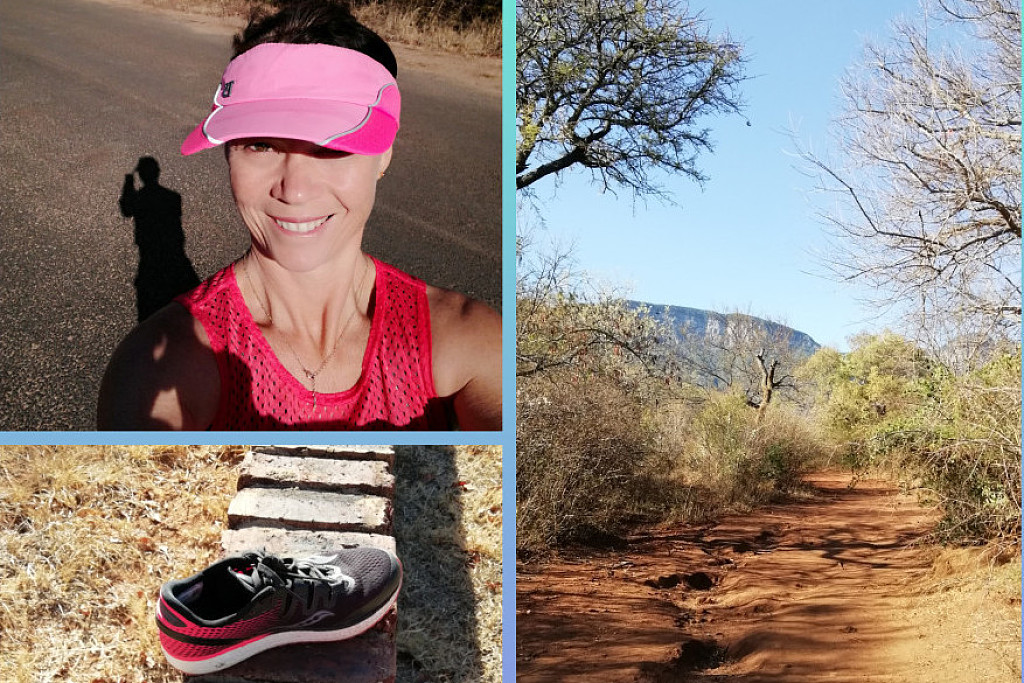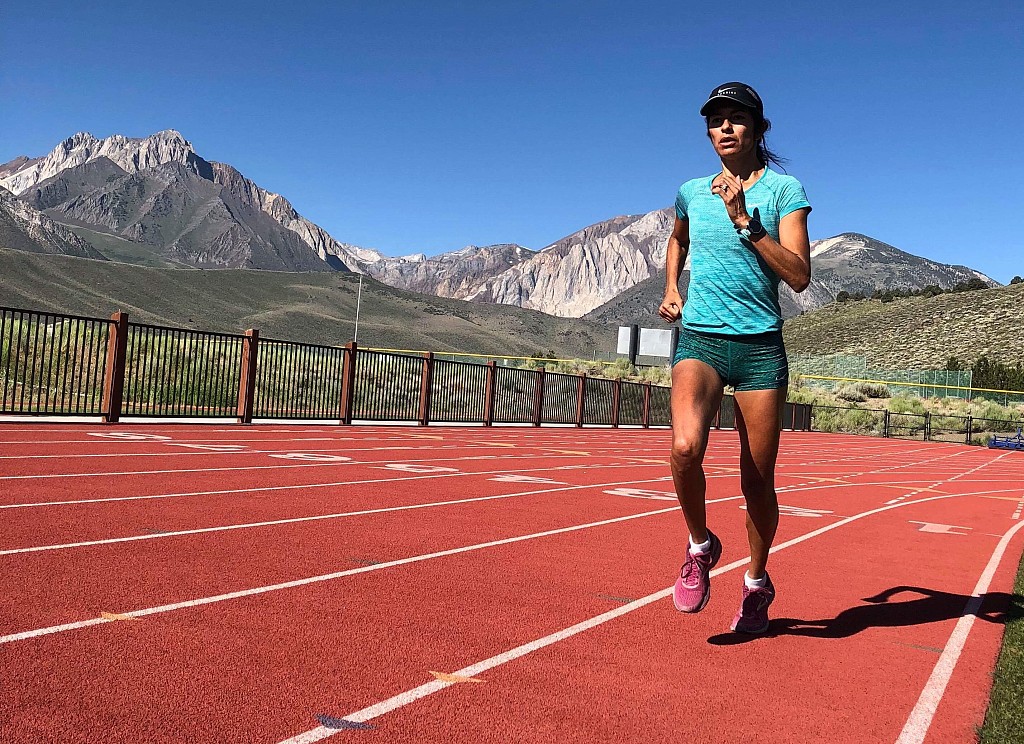Running News Daily
Running News Daily is edited by Bob Anderson. Send your news items to bob@mybestruns.com Advertising opportunities available. Train the Kenyan Way at KATA Kenya and Portugal owned and operated by Bob Anderson. Be sure to catch our movie A Long Run the movie KATA Running Camps and KATA Potato Farms - 31 now open in Kenya! https://kata.ke/
Index to Daily Posts · Sign Up For Updates · Run The World Feed
Articles tagged #Larry Allen
Today's Running News
People are still running in Central Park but the thought of it now makes me nervous
(Editor’s note: I asked my friend Larry Allen to give me his overview of the situation back east due to COVID-19. Larry is a lifetime runner and is a cancer survivor. Him and his wife live in New York City and has a weekend house in Connecticut.)
“Hi Bob, Sorry to be so slow to respond. We are in Connecticut at our weekend place. We were without internet for 10 days, our cell service is nil and our phone only functions with working internet. It was a real catch22 to find a way to get a service appointment, certainly because we were untethered digitally but more so because the ISP was overwhelmed and.short staffed. We finally got through on Twitter and now with a new router & modem I think we’re back in the modern world, to the extent we can bear to be.
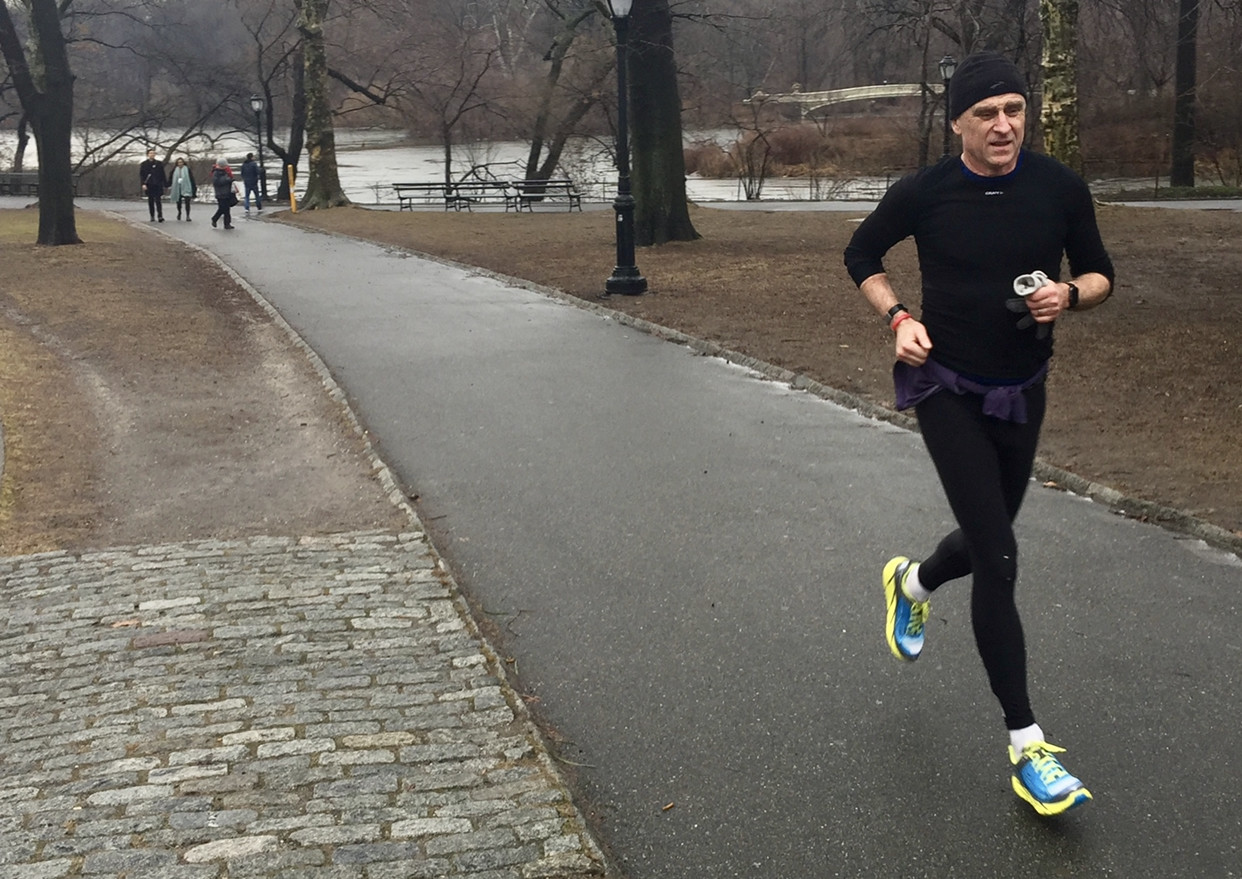
"My oncologist and my internist essentially booted me out of the city in early March due to my still compromised immune system. I was due to have a CT scan and some other post-chemo exams a month ago, just to be certain all was still ok and that I had no reoccurrence of the cancer. Unfortunately the Doctors won’t let me near a hospital, they explained that the risk to go without followup exams for the near term was less than the risk of showing up at the hospital and possibly being infected with my immune system as it is.
"We are safe here for now. Concerned about the food supply and basic services but there’s not much more to be done than hunkering down and hoping that the trends begin to turn.
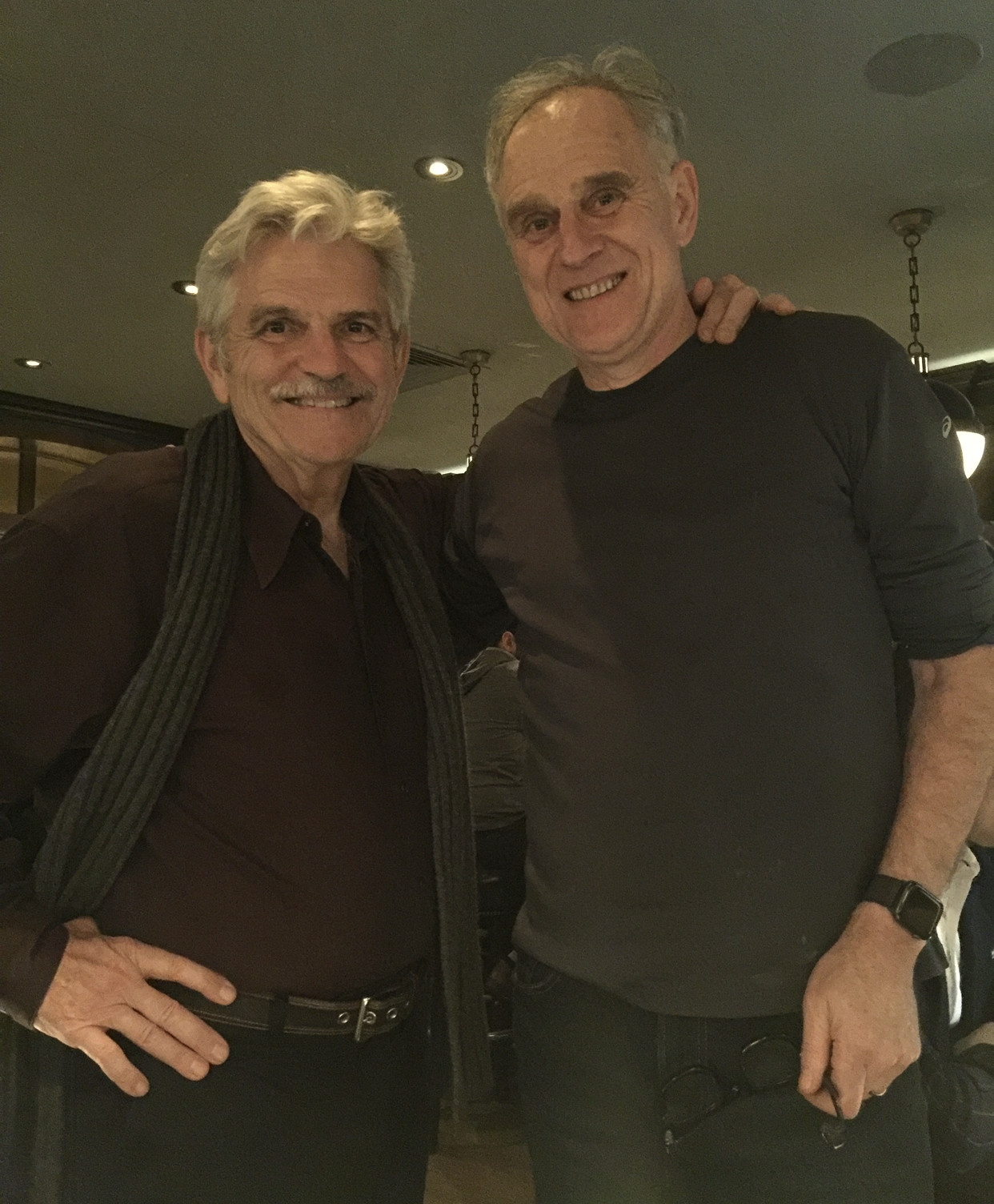
"I’ve been able to continue running six days, 25-35 miles a week. I try to go to the rail trail near our home which is usually my peaceful place. The odd hybrid bureaucratic nature of the shared federal/state/local responsibility for the trail has spared it from being closed as is the case for all other state and local parks with less complicated governance. The bad news is this: there are huge numbers of people suffering from “cabin fever” in lovely spring weather after a long winter and too few places for people to get out for some exercise. Naturally the rail trail has gotten too crowded for safety so other than going at dawn or dusk or during a rainstorm it’s not really an option. I guess it’s somewhat of a blessing that there are far fewer cars on the road so hitting the pavement is less treacherous than it might be. One has to assuming e the air quality is better too.
"As you know we live very close to Central Park and it is one of my favorite places to run. I really enjoyed running with you there last year.
"People are still running in Central Park. I don’t know how but the very thought of it makes me very nervous now."
(Photos: me a couple of weeks back, enjoying a run with Bob in the park last Feb 2019 and Bob and I at a Speak Easy the night before. Bob's wife Catherine took the shot. When life was normal.)
by Larry Allen
Login to leave a comment
Is there a time when an indoor track event should be stopped to help a fallen runner like Komey Campbell?
Is there a situation when a race on an indoor track should be stopped when a medical emergency happens to one of the runners?
If something happens to a football player on the field, the game is stopped so full attention can be given to the fallen player. There seems to be a protocol in place for such situations.
If there is a medical situation at a road race, 911 is called and a medical team is there on the spot normally within minutes. There is normally plenty of space on the road so the race does continue and the fallen runner is given full attention by the medical team.
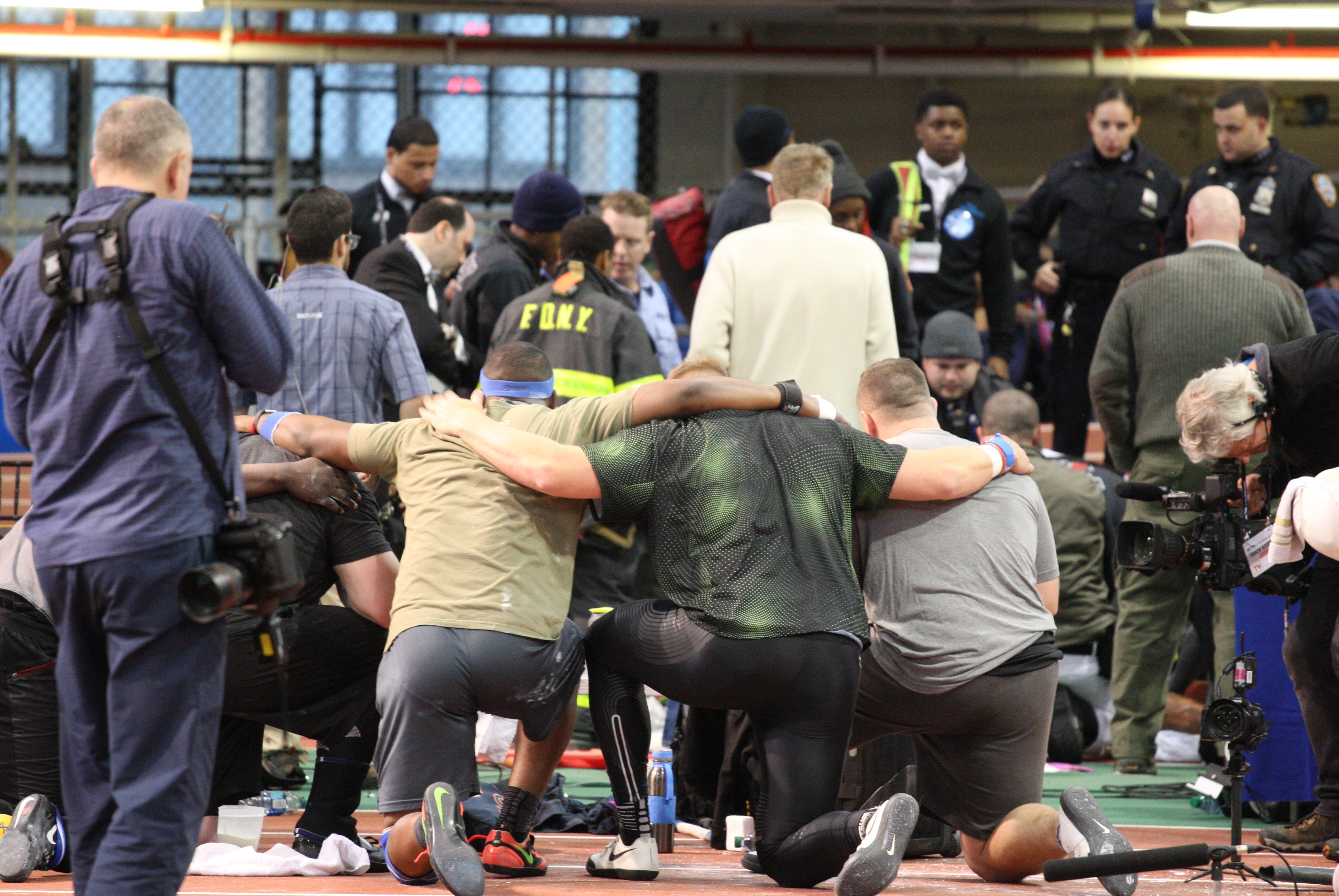
Indoor track is a different situation. The space is more cramped and unlike a road race, runners are passing the same spot every 29 to 35 seconds or so. Being on an indoor track is like being on a busy freeway compared to being on a country road.
On Saturday Feb 9 at the Millrose Games in New York City the pacer, Kemoy Campbell for the men’s 3000 went down early in the race.
Larry Allen who was watching from the stands describe the scene. “The 3000m pacer, a Jamaican 2016 Olympian at 5k went down very suddenly right past the apex of the first turn after about 1000m and landed just off the track surface on the infield. He was clearly unconscious when he landed,” wrote Larry in a text.
“He was down for 23 minutes (by news reports) and never moved a muscle. It took at least 2-3 minutes before anyone administered any medical help and then according to my Doctor friend, watching the meet with me, the mouth to mouth resuscitation efforts aren’t the current protocol.
“CPR was crucial and it was a couple of more minutes before it was administered and according to my friend (in real time) the only thing that could’ve really helped was a portable defibrillator and I learned that it must be administered within 5 minutes in order to assure oxygen supply to the brain is maintained.
“It was 7-10 minutes before he was shocked. There were a series of different people that attempted to resuscitate him by cpr (& mouth to mouth) before (and after) his heart was shocked.
“There is a major hospital (Columbia Presbyterian) right outside the armory on that side and it is ultimately where he was taken. News reports today indicate that he is in the ICU in a medically induced coma.
“It was traumatizing to witness up close. My friend wanted to climb down from the balcony to try and help but there was no real way for him to get down and the back up over the banked track and fence along the top. He was and is tormented by his inability to be in a place to offer help,” Larry concluded.
This article is not meant to bring blame to anyone or any organization. In all the years I have been following track I can not recall a similar situation. I am sure no one would have ever dreamed that something like this would ever happen.
This was a well conditioned athelete and a runner qualified to pace such an elite field. It should not have happen but it did.
The scene was very distributing for all of us there Saturday afternoon at the Games. In my thinking it just makes the performances after the event even more amazing. It is hard to imagine that Yomif could have 100% blocked out the traumatic scene that had just unfolded. But maybe since he does not speak English he did. In any case he almost set a new world record for the mile just 20 or so minutes after Campbell was removed from the stadium. It was an amazing race to witness up close and personal right at the finish line however there still was somewhat of a fog hanging inside the arena.
There is a question that should be addressed. Should the 3000m race have been stopped so full attention could have been given to the down runner? As it was, runners kept flying past him for several critical minutes making it more challenging for medical personnel and equipment to be at his side.
We hope that Kemoy Campbell will be able to have a full recovery. Our hearts go out to him and his family.
by Bob Anderson
Login to leave a comment
My Love Affair with Central Park started 40 years ago tonight - Larry Allen on Running File 5
If you want a useful guide for running in Central Park this isn’t that. There is plenty of concise information available online and all of it will do a far better job telling you exactly how to go for a run in New York City’s favorite 840 acre backyard.
If you want to know about beginning a long term relationship with New York City and running in Central Park, this is my story.
My first run in the park was on December 29, 1978. I was in college on the GI Bill and had taken my slightly unreliable but fun-to-drive MGB from Maine to Florida over Christmas break.
I didn’t want to think about the trip back north. Hitchhiking was still an option in those days if my car gave out but it surely was not what I wanted.
I was already a veteran of two marathons and was ramping up my mileage for the Boston Marathon the following April. I had a glorious couple of weeks of running in the technicolor light and warmth of south Florida and while there even managed to meet Frank Shorter.
I ran twice a day including a couple of two hour runs, went to empty beaches to bask in sunny 60 degree days while bundled up locals looked on, amused and mystified.
All in all it was a great time, went quickly and too soon I was starting the long drive back to Maine.
A couple of uneventful days on the road brought me back to the NJ turnpike two days before New Year Eve. In the fading light of a cold, clear winter afternoon I pulled into a service plaza for gas.
My plan was to continue driving on through the night for the last 500 plus miles vs. spending money I didn’t have for a roadside motel room. A “you are here” map in the foyer of the restroom surprised me with my close proximity to NYC.
The next thing I remember is rummaging through the stuff in my car for an address book with the phone number of a longtime summer friend from Maine who spent the balance of his life on upper west side of New York.
I searched between the seats for change to make a call on a pay phone and was fortunate that my friend even answered. He graciously said I could crash for the night.
I’d never even been into NYC proper and the prospects for the evening were exciting if not a little intimidating.
I finally made it safely down from the high bridge over the Hudson River into the city and found a place to park near Grant’s Tomb on Riverside Drive, a few blocks west of my friend’s apartment not far from Columbia University.
I made the wise choice to schlep all of my stuff to the apartment for fear that the patched convertible top and dodgy locks of my car wouldn’t deter anyone in 1970s NYC, from breaking in looking for anything of value.
I said a quick hello and thank you to my friend on arrival but needed a run before I could eat or do anything else. He understood and gave me directions to Central Park and showed me how to buzz myself back into his high rise building.
Running down Broadway entailed dodging and weaving along hopelessly crowded evening sidewalks, scents from all manner of ethnic food wafting as I made my way through the 20 red lights, one per block, for a mile.
Eventually a left turn, to the east for a few more blocks to enter the park around 100th St at Central Park West.
The park was dark and cold, full of energy but it oddly felt peaceful too. The air was filled with different smells; diesel bus fumes, horse manure, musty fallen leaves, street pretzels, roasted nuts and yes, adrenaline, some of it mine.
Traffic hadn’t been banned from the park drives in the evening yet so it was full of yellow cabs and giant 70s era sedans moving slowly in heavy evening traffic.
I looked around for a landmark, something to remember so I could find my way back out of the park onto the same street in hopes of finding my way back to my friend’s place through what felt like barely contained chaos on the city streets.
I took note of a broken, graffiti covered park bench in this far less than gentrified version of the city. It seemed memorable enough and I guess it was.
Inside the park there was a lane for running. Parallel were two traffic lanes around what I’d been told was a six mile loop circling the park just inside the perimeter.
In spite of the hummock and pot-hole filled streets, particularly in the nearly bankrupt version of the city at the time, I recall the park drives being remarkably smooth pavement.
I turned right, running downtown on the west side. The rolling hills also seemed more downhill than up too, something I confirmed in years and miles to come.
At first it was a gentle contained pace, working out the stiffness in my legs and back after a day long drive from North Carolina on a bad suspension and the hard seats in my car.
The grade of the rolling hills and gently winding turns in the park seemed worn-in to the landscape. It felt perfect for running, almost carved into the city like the equivalent of glacial wear but from the mass of some number of the eight million city residents using the park day after day.
Making my way down the west side for a mile offered peeks through the leafless trees and scenic overlooks of the lights and architecture of pre war apartment buildings forming what appeared to be a tall, impenetrable wall along the avenue fronting the park.
Periodically there were glimpses further downtown to the iconic skyscrapers in midtown. The Empire State Building and Chrysler Building most familiar amongst a forest of others that seemed just as big if not as well known.
I simply didn’t want to stop running, the pull was almost magnetic, my tempo gradually increasing around the next corner or over the next hill, all just to see what was ahead.
It was all a bit like a party that you didn’t want to leave for fear of missing something good that might happen.
Just before reaching a first opportunity to choose between veering left from the main park drive or continuing straight toward the high rises of midtown; I went by what, in a few years, would be renamed Strawberry Fields. It was in honor of John Lennon; murdered not far away at the entrance to his building, the Dakota, which overlooks the park here.
The park is a perfect rectangle, slightly off of an exact north to south axis extending from 110th St to 59th St., 2.5 miles on each side and slightly over .75 mile between 5th Avenue on the east side and Central Park West on the other.
Years later I learned that the cutoff (or shortcut) I had seen and gone by at 72nd St and another I hadn’t reached yet at 102nd St made for a seemingly endless variety of options for creating and running multiples of loops of 2, 4, 5 miles and of course the full 6 mile circuit.
The New York Road Runners used the counterclockwise 6+ miles of the full park four times plus the slightly less than two mile loop from the bottom of the park to 72nd St for the 26 miles 385 yards for the 55 finishers of first New York Marathon in 1970.
The marathon still uses the park, but only about half of it for part of the final three miles of the race.
I read somewhere that 20,000 people run in Central Park on an average day. There are days and seasons during the year when that number seems high but other days and times during the year when it is certainly low. I guess that’s what they mean by average.
There are over 30 races in Central Park every year. Most hosted by the New York Road Runners Club and a few by other organizations.
Nearly all have thousands of participants, racing distances ranging from a 1 mile kids race to a 60k ultra marathon. Some with top invited international and American stars, some simply very large competitive local races. Every one a variation in the options for running loops in the park.
I continued running through the park, next past a big open meadow on the left, learning later that it was the 15 acre Sheep’s Meadow.
It has been a historic spot for protests over the past 100 years, up to 30,000 sunbathers on a nice day and 150,000 for a Barbra Streisand concert in the 1960s and yes sheep, from the 1860s until the 1930s.
Adjacent to the finish line of the marathon at Tavern on the Green the meadow also was a post race staging area for a few years.
22 months after my first run in the park I was back here, finishing my first marathon in New York. My last run up the hill to that familiar finish line was 32 years later.
The buildings along the southern edge of the park loom up just a few hundred yards away from the marathon finish. Columbus Circle marks one of the four corners of the park here and is a block from where I lived for 10 years when I finally moved to the city.
Almost every day was a 15 minute walk home from work at MoMA for me, dogs out for a walk and then into the park for an evening run. Sometimes clockwise, up the westside, the opposite direction of my first run.
Often I ran the same counterclockwise direction I was running that night. Across the bottom of the park to the east side, the legendary Plaza Hotel, the Central Park Zoo and the Wollman Skating rink anchoring the corner on that side.

I saw the familiar sign for the Essex House hotel along the way on my first run in the park that night and invariably still take a glance up at it on every run 40 years later.
Turning back north on the east side of the park led me up a gentle hill through dramatic exposed rock outcroppings of Manhattan’s bedrock schist. Apparently something which allowed New York to more easily build foundations for it’s famous skyscrapers over the last century.
I ran past playgrounds, the 100 year old children’s carousel and about a mile beyond Columbus Circle, to the other end of the 72nd St cutoff.
In years ahead it became a familiar corner. Nearby is the start and finish for the New Years Eve 4 mile race in the park, starting at the stroke of midnight with fireworks.
The corner is also near the start of one of the bigger hills in the park, this one known among local runners as “cat hill”. Midway up the 1/4 mile climb is a sculpture of a life sized and menacing mountain lion, seemingly ready to pounce from a natural stone overhang directly over the runner’s lane.
It was too dark to see the cat that night but is familiar enough now. Cat hill is a popular place for training for some of the dozens of running clubs that meet up and use the park for weekly group training sessions.
A couple of minutes more led me past what I didn’t know at the time was the back of the massive Metropolitan Museum of Art. Around it and closer to 5th Avenue for another half mile brought me near a building I did recognize, Frank Lloyd Wright’s landmark cylindrical Guggenheim Museum.
The nearby entrance to the park would become familiar later as the place where the marathon enters the park for the last 2.5 miles of the race headed back in the direction from which I’d just come.
The summer after my first NY marathon and having entering my 2nd, there was a fundraising appeal in my race confirmation. The NYRR was trying to raise money to purchase a six story Beaux Arts townhouse just opposite the Guggenheim for one million dollars.
They were successful and for 36 years it served as headquarters, clubhouse and place to pick up bibs for their many races. It was listed for sale this past year for 25 million dollars as they apparently need something fancier and/or bigger.
Nearby is a statue of the late, charismatic leader of the NYRR, Fred Lebow. His vision arguably responsible for the explosive growth of urban marathons around the world for decades. His likeness stands looking at a stopwatch, appearing to be silently calling out time splits to runners just inside the park.
The entrance of the 1.5 mile long reservoir running path is there too, named for Jacquelin Kennedy Onassis, a nearby resident for decades, she was known to jog on the scenic cinder path and reportedly was even seen wearing long white formal evening dress gloves on cool days.
At the reservoir it felt like I had run between 5-6 miles, I knew it was six around the park but then maybe 10 minutes more to and from my friends place.
I was moving along briskly, feeling good but thinking I should get back but had reached the point where it made more sense to continue on vs. turning back. Maybe three miles to go.
Just 1/4 mile past the flat straight section along the reservoir the drive started down a hill and turned toward the center of the park from the perimeter. I felt a change. There were fewer street lights, less traffic and not as many people around. It all seemed a bit more ominous.
A half mile further brought me to the 2nd cutoff between the east side and the west. This one at 102nd St. It was very dark, narrow and almost foreboding.
In 1989 this section of the park, down the hill from the reservoir to the 102nd St cutoff became notorious as the site of a series of “wilding” gang assaults on a number of runners and pedestrians over one hour on a frightening night that April. It culminated in the vicious assault and rape of the “Central Park jogger” on the cutoff road I was passing.
Even 11 years prior to that night it felt dangerous. Today most runners and running clubs practice a buddy system when running at night in the park as a result of what happened in 1989.
There is a prominent police presence in this area and thankfully crime in the city and the park has declined precipitously too.
In all of my thousands of miles in the park over the years, many at night, I’ve never personally experienced a threat or even witnessed one and I’m grateful for that.
The almost kaleidoscopic park quickly changes again at the far north end. The park drive quickly snakes through a steep S shaped descent with high bluffs overhead on one side and an open high view of Harlem on the other; the Meer waters and the Conservatory Gardens in the foreground.
The far north end of the park remains the most natural with unspoiled ravines, dramatic rock faces, waterfalls and streams all tucked away.
On runs here I’ve seen families of raccoons crossing the road at night and hawks swoop down for unsuspecting squirrels during the day but nothing of the sort on this particular night.
Midway down the hill brought me past a large skating rink outfitted for youth hockey. I learned later that it does double duty as a community pool in the summer.
Now at the north edge of the park I could see into Harlem. I made the turn, running to the west. Just outside the park were dilapidated tire changing shops, gas stations, boarded up windows, burned out cars and a trash can with a makeshift bonfire offering warmth to a few men huddled around.
Continuing on, anticipating a turn to the south to complete my circuit of the park it quickly became evident that I was going to climb a good hill.
Runners in NY refer to this climb with some dread as THE Harlem Hill, it climbs about 150 ft in half a mile and then just as quickly drops down again. I wasn’t far beyond where it leveled out again and suddenly on my right, there it was!
The familiar broken, graffiti covered bench that I’d decided to use as part of my trail of bread crumbs when I entered the park.
Not much had changed on the surface. Traffic had lessened somewhat as the evening rush was concluding. The smells were the same but had become permanently imprinted in my brain vs. something new to experience.
I slowed my pace for the few blocks back toward Broadway and a final right turn north for the last mile up toward Columbia.
After less than an hour on foot I felt like I understood New York to some extent....and I liked it. The prospects for the evening seemed exciting enough when I decided to spend the night but I had no idea.
Even before I finished the run one big thing had changed. I knew or at least hoped that I’d spend part of my life in the city.
My wife, step daughter and I have been fortunate to have lived the last 21 years of our life together in New York and adjacent to Central Park, 10 years on one corner of the park and the last 11 years a few blocks from the far opposite corner. In part, all due to one unforgettable run around Central Park on a cold December night 40 years ago tonight.
(Larry Allen on Running is an exclusive My Best Runs Running News Daily feature. Additionally Larry is doing the Run The World Challenge for the third time.)
by Larry Allen
Login to leave a comment
Merry Christmas to all our My Best Runs followers from Bob Anderson and staff
We have been up here in Bend Oregon visiting my son and his family since Friday. My son Michael Anderson is our MBR results editor and post results as soon as they become available. Sometimes it is as soon as the first runners are crossing the finish line.
Michael (top photo) have carved out many running courses around his house. We have already run 22.2 miles since Friday and will at least get in six miles today.
Last Christmas Michael lived in Eugene and we ran the Pre Trail Christmas morning.
We have been running on Christmas Day forever. When Michael lived in the Bay Area I would run with my daughter Lisa and her family and then run with Michael in the afternoon.
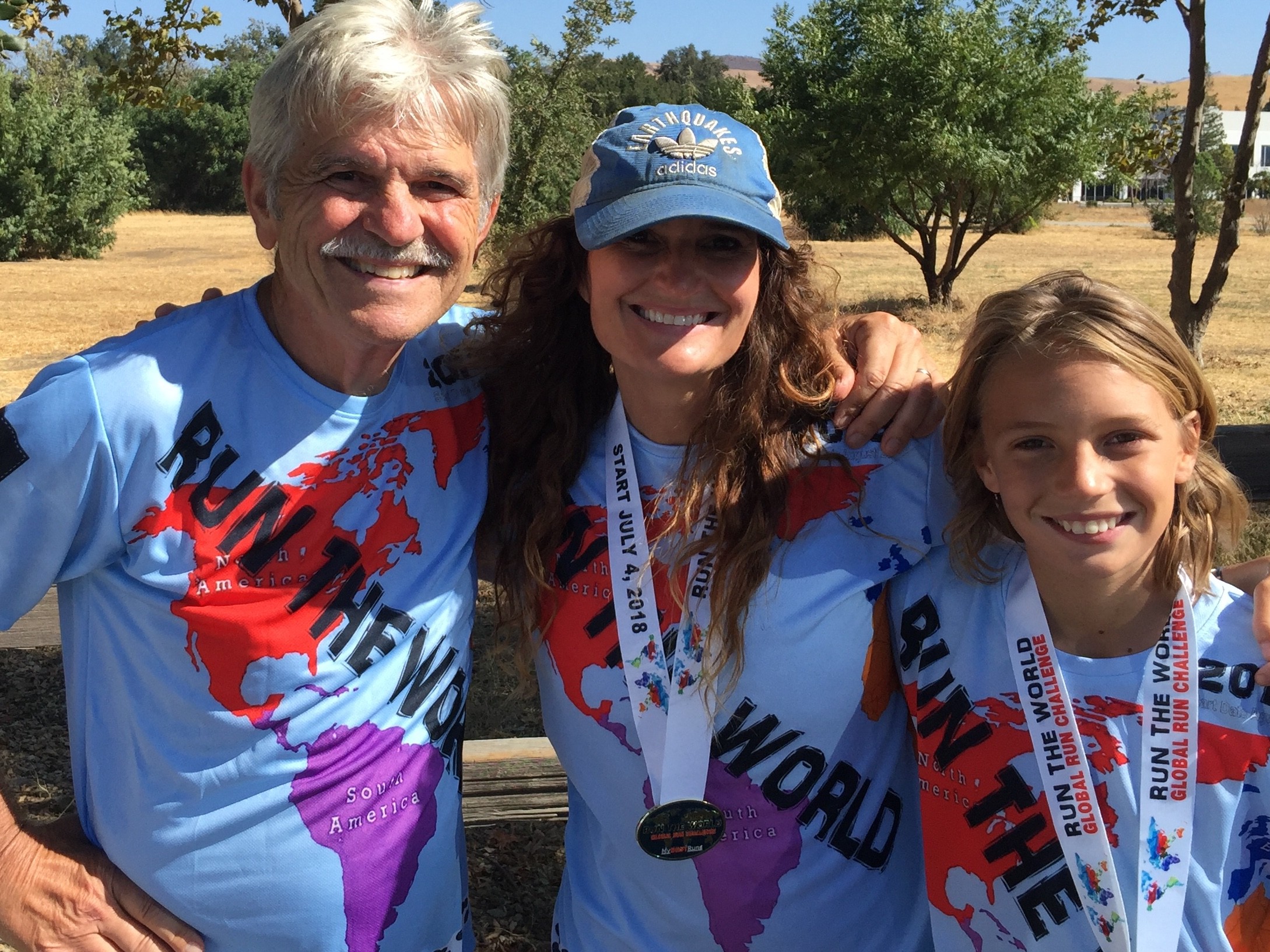
Lisa (second photo) and family lives in San Jose, California. She is our social media and newsletter editor. We celebrated Xmas with them before heading up to Oregon.
Both of my kids have run marathons, my wife has run a half marathon and many other races but after operations on both feet can’t run now (Catherine works out at the gym these days) and all my four grandkids run even including my two year old, Bear. Owen age 12 have already run a 5:52 mile. My son-in-law Justin has run a 1:27 half marathon.
We are a running family and have been forever. There is no better day than Christmas Day to get outside and get in a few miles. (Updated: Mike and I got in 7.1 miles through two inches of snow today.)
Two other members of our full time crew are Jaime and Manuel. They work at our La Piedad office.
Our webmaster Waitman Gobble keeps us all working and always is coming up with new features.
Gary Allen (Marathon Man Gary Allen) and Larry Allen (Larry Allen on Running) have signed on to do regular writing for us sharing their many years of running wisdom and knowledge with us. I am sure they will be getting out and getting in a few miles today.
Willie Korir is located in Nairobi, Kenya and has been sharing insights into what makes many runners in Kenya superstars. He has also run and logged 2851 miles for our three Run The World Challenges since July 4.
Our third Run The World team is not too far off of running and logging enough miles to circle the planet for the third time. I am so proud of our team.
Merry Christmas and Happy New Years to everyone. Be sure to get out today and let’s all make 2019 a super year. I know this is our plan here at My Best Runs.
by Bob Anderson
Login to leave a comment
It is important to understand that we are not bullet proof as runners - Larry Allen on Running File 4
I went out for a slow, difficult three mile run the evening prior to my pacemaker being implanted. My heart, although not functioning properly, was thankfully strong enough for that one last run without artificial help.
My friend, a nurse, probably saved my life by getting me into a walk-in clinic that next morning. Everything went fine and I am now running again but with a pacemaker (recent photo in NY Central Park).
Let me share some advice. There is a fine line between being tired or feeling weak from a hard workout or thinking maybe fatigue or weakness is “just” natural decline with age making things harder vs. something feeling “off” enough to seek help.
It’s a blurry line but I guess my best advice is to be keenly observant of your own physical traits and patterns and when anything falls outside of a normal range for you, again, see someone. I think it’s very important to understand that we aren’t “bullet proof” as runners.
I remember in the 70s Dr. George Sheehan wrote and in lectures said that we, as marathon runners, were essentially immune from having a heart attack. It wasn’t long after that Jim Fixx died of a sudden heart attack while running on an easy training run.
Almost every day when I run in Central Park in NYC I run right by the spot where Ryan Shey died suddenly of an undiagnosed cardiac condition early in the 2007 Olympic Trials Marathon, on a downhill section, it was a cool day and the pace early in the race was conservative (for him).
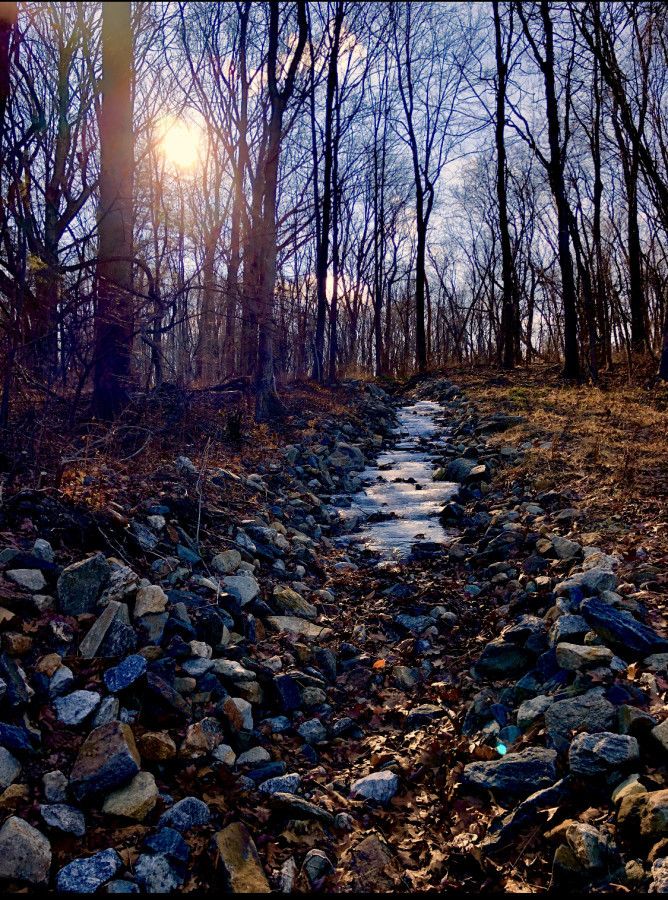
A friend, physician and Olympic Trials qualifier in the marathon from Maine has a sad but growing list of lifelong runners from northern New England alone that have met similar fates without knowing they had a health issue.
We have to understand that even as very fit runners we are vulnerable, and that goes hand in hand with understanding the importance of listening to your body.We all have to be our own best advocate and our own best piece of medical monitoring equipment.
It’s easier with all of the new technologies however, as runners, we have intuitive ability that puts us in touch with our own bodies. We must listen carefully to all of it and also try to overcome another trait we have as runners, our stubbornness, which can certainly be our strength and our weakness at the same time.
Recovery has been tricky. After my pacemaker was functioning I was diagnosed with intermittent (paroxysmal) Afib which is treatable with medication. At first I didn’t quite understand that Afib progressively becomes more persistent or permanent and that treatment options become less effective or sometimes completely ineffective as it goes along.
I ran again for a bit over a year but my Afib was gradually getting worse and eventually the stronger medications needed weren’t easily tolerable. It got harder to run yet again. My remaining option was a cardiac ablation. After careful consideration I had it done early this past summer.
The good news is that my Afib has not reoccurred since. The bad news is that it’s a lengthy healing process. I am six months into it and have probably walked about 600 miles. I’ve gradually added short stints of jogging into my walks and only recently a few miles of continuous very slow running.
I’m told that it will take perhaps 3-5 months to fully heal and hopefully then I’ll be able to run more normally.
(Larry Allen on Running is a regular MBR feature sharing the wisdom of Larry Allen, a 50 year accomplished runner and artist. He is currently participating in the third Run The World Challenge.)
Login to leave a comment
My coach said when passing someone, pick up the pace, go by with certainty and show no sign of exertion - Larry Allen on Running File 3
Full circle. I am becoming Fred Dingley. He was my first cross country coach at Lee Academy way back in 1969.
One late summer day a couple of years ago I headed for my usual early evening run at a favorite trail in Connecticut.
A welcome hint of fall was in the air. Dry, refreshing Canadian high pressure, breezes and gentle fall-like light had crept in for the first time in months, replacing the laser-bright sun and stifling humidity of a hot summer.
The trail I often run extends along the Pequonnock River Valley and the beautiful weather had it abuzz with happy runners, cyclists and walkers, a full house in the parking lot.
At the top of the short hill leading from the lot to the trailhead; 15 young men from a local high-school cross country team gathered, bare-chested, stretching against a rail fence.
The 14 year-old newbie kids tried not to be conspicuous in their very presence but also were clearly checking out their bigger, stronger and more confident 17-18 year-teammates. The older ones innocently full of themselves, utterly oblivious to the younger kids.
They all started running just before I shuffled up onto the trail. Within the first half mile I could already see the smaller, slower runners beginning to fall off the pace.
I caught the first kid soon after. For a minute I was back in the early fall of 1969. My first coach, yes Fred Dingley, was the headmaster of the school.
In his 60s, he ran with the team some days. I was 14, 4’9” and weighed maybe 90lbs. I lacked fitness, confidence or any knowledge whatsoever.
Mr. Dingley caught me a few times in my first few runs that September and always had a word of encouragement as he passed.
He made me feel like if he could run 2-3 miles at his age I damn well could, even when I seriously doubted it two steps prior to him passing and three steps after he went by.
Fred Dingley's teams were a perennial power in Maine. State Champions my first 2 years. My next coach, Howie Richard, led a team to my third championship in 4 years. I was fortunate.
Early that first September I ran my first timed mile in 6:55. I proudly made my way to the top of the Junior Varsity by the end of the year and ran a 5:06 mile.
I won a race the next year and I will never forget being congratulated by the headmaster-coach in the school’s morning announcements.
Mr. Dingley retired a year later and I've always hoped he kept running for years after.
40 odd years later, I ran past the slower runners in the first couple of miles on the trail and made a point of doing what my coach had done; offering a quiet word of encouragement to each kid.
I wondered whether seeing a man in his 60s running by might do for one of them what it did for me years before.
Meanwhile, I also remembered how Howie Richard coached me as as a more accomplished runner 3 years later; he said when passing someone, pick up the pace, go by with certainty and show no sign of exertion, he explained, only slightly in jest, that "it demoralizes them a little and gives you an edge".
Maybe I should regret those ingrained competitive instincts but at more than 4 times the age of most I passed I think I should get a pass (no pun intended) for any insensitivity, real or imagined. I did try offer encouragement but that's a different thing, right? Can you intimidate someone (a little), feel better about your own remaining ability and give encouragement all at the same time? I hope so.
I have no idea whether the team I saw in Connecticut that pre-season evening ended up a top team that year. I was impressed that most of the older kids ran the same 8 miles I did.
Based on those I passed, I remember wondering whether I might still be able to make the JV team of a HS team. In reality the dead sprint at the beginning of a 3mi high-school cross country race would be a big problem.
If I had any hope I’d have to use experience and wisdom (if any) to try and overcome my physical ability with a late charge from behind at the end. The real problem; the youngest and slowest kids I saw were all going to get much faster and stronger in coming months. I would not.
At just past age 60 I was still holding up ok. I could still manage 5-12 miles almost daily. A few longer runs crept below 8 minutes per mile, I even managed a 6:25 mile at the end of one good run. It all took a sudden turn with an unexpected health problem a short time after this particular evening.
Having successfully dealt with my issues I’m again able to run or run/walk for shorter distances on the trail weekly, slower but just as happily. I still see competitive runners and teams, maybe the same ones; a few looking like collegiate runners home for a visit, some likely former undeveloped youngsters but not so much anymore and of course always a new crop of nervous 14 year old prospects.
As for me, maybe I should just be happy being Fred Dingley.
(Editor’s note: Larry Allen on Running is a regular MBR feature sharing the wisdom of Larry Allen, a 50 year accomplished runner and artist. He is currently participating in the third Run The World Challenge.)
by Larry Allen
Login to leave a comment
We live for that effortless and balanced feeling like you are floating above the ground - Larry Allen on Running File 2
It’s really impossible to pick one race or run as best or most memorable in a 50 years of running. I guess if I had to pick one thing it would come from the occasionally feeling one gets in a run or race, when it’s suddenly well within your ability and training, just effortless and fast, finding yourself perfectly balanced and feeling like you are floating above the ground and periodically reaching down with one foot or the other and giving yourself a little push to maintain your momentum and with little or no limits to how long you could keep it up.
Pure magic and joy whether in a training run or race. At it’s best “that feeling” was somewhat elusive when even a very fit young runner and certainly more so as we age.
There is still a strong pull to get out every day to try and find a glimpse of it regardless of the likelihood that you won’t. I’ve always thought that B.F. Skinner’s psychological studies of the power of variable, unpredictable patterns of reinforcement to modify our behavior were likely at work and I’m good with that.
My running friends and peers of a certain age and vintage share a little joke about the rules of gravity of middle age (and beyond) being clearly quite different than anything Isaac Newton theorized.
(Editor’s note: Larry Allen is a 50 year runner and artist (self portrait). His wisdom and knowledge of our sport is impressive and this is why we asked him to regularly share his thoughts here - Larry Allen on Running. He is also participating for the third time in our Run The World Challenge.)
by Larry Allen
Login to leave a comment
We all thrive on solo runs but the camaraderie of a group or team run is special - Larry Allen on Running File 1
Funny thing about running. A lot of it is solitary and we all thrive on being alone so its fine, at least part of the time. Meanwhile there isn’t much better than the camaraderie of a group or team run.
Conversations wax and wane and the personal bonds formed and memories made are often inseparable and indelible. The miles disappear, the pace quickens and the distance covered grows, it’s somehow invariably easier to be inspired to do more as part of a group.
It seems like we runners need a little of both; the quiet of running alone, lost in thought but with a good dose of runs on a team or with a friend or friends. Both have a place and are magical in their own special way.
Bob Anderson’s MyBestRuns hosts a periodic online event, repeated through the year, called Run the World Global Challenge and it fosters what we do alone and the joy in being connected while doing it.
Each event involves a hundred runners or so from all over the planet having signed up and committed to a cyber team effort to accumulate the running and walking mileage necessary to circumnavigate the 24,901 miles around the planet earth over a couple of months.
Participants post a daily (or in the case of some serious athletes, multiple times daily) run or walk, with a picture and little diary entry. I think most of the miles by all involved are solitary but all as part of the team effort to accomplish a goal bigger than any one of us.
It’s a unique, fascinating and inspirational use of social media. It has motivated me personally to do more, to be earnest in my efforts to rehabilitate my body following some personal health issues. There is a commitment, low key personal accountability, a real sense of achievement and camaraderie as words of encouragement and quiet competition creep in as we each do our part to collectively make it around the world.
The often lovely posts feature photographs of places run and selfies taken that somehow serve to enlighten and makes the world a smaller and more peaceful place, slightly reminiscent of the way world travel does.
I’m midway through my third trip around the world since July. I’ve contributed a total of about 500 miles, about the distance from my adopted home in New York City to my native eastern Maine.
This third team has already made it 8,850 miles in the first 25 days of running and walking (and posting). We’ve done enough to make it roughly from California to Europe and at our current average of about 350 miles per day we will have made it around again on about January 8th of the new year.
If so it will have taken us a total of 71 days, a good 9 days faster than Jules Verne imagined and fantasized about back in 1873. Go team!
(Editor’s note: Larry Allen is a 50 year runner and artist (self portrait) who currently is dealing with a health issue.
His wisdom and knowledge of our sport is impressive and this is why we asked him to regularly share his thoughts here - Larry Allen on Running. You can also follow Larry on our RTW Challenge feed.)
by Larry Allen
Login to leave a comment
Runing is very important to me, it fits right in with eating, brushing my teeth and sleeping - Larry Allen On Running Intro
I am Larry Allen. I am 64-year-old, a 50 year runner and doing the Run The World Challenge for the third time.
In 1965 I was living in Maine, Great Cranberry Island. A small, isolated, offshore island adjacent to a national park with only 80 residents. I started running there and achieved some success and in 2016 I was inducted into the Maine Running Hall of Fame.
Running is very important to me. Without intending to overstate it, running fits right in with eating, brushing my teeth and sleeping. Obsessed is another word although I think over the years the obsession has been moderated to a healthier place.
My mental health depends on it to an extent. My creativity, well being, problem solving, peacefulness and certainly my ability to stay centered and in balance with life itself have always been better when I’m running.
"He is a New York City artist, who retired as the director of publishing for the Museum of Modern Art in Manhattan, “painted” in many different styles and left a truly remarkable body of work," a friend wrote.
I keep busy as an artist and as a part-time manager of the business affairs of my still very active wife Kristen Blodgette. She’s a professional musician, Musical Director, Conductor and Musical Supervisor, principally having been associated with Andrew Lloyd Webber for his Broadway and worldwide productions for over 30 years.
We live in New York City and in Fairfield County Connecticut. "Larry has run some impressive times over a wide range: 440 (51.7), 4:34 mile, 15:58 5k, 33:26 10k and a 2:46:20 marathon. He has directed many races, coached and written a lot about the sport.
When Larry turned 60 he wanted to run one more marathon," wrote Bob Anderson. I had a good year, a steady 60 miles per week. I was going to run Philly in November but about three weeks prior I tore a calf muscle severely and that was that. When I started running again about six weeks later I felt a profound fatigue and weakness that I didn’t recognize.
I assumed it was age but it was unsettling and very difficult. An old running friend and ER nurse saw the significant dip in my ability on a social media running tracking app and called me. She essentially did triage over the phone from 500 miles away and asked (told) me to immediately go the nearest walk-in clinic and to tell them she had sent me. After an EKG the doctor came into the exam room and said 'I don’t want to alarm you but you are in complete heart block and and we’ve called an ambulance.' I didn’t quite understand what heart block was but learned later that it was electrical in nature and not blocked arteries.
After emergency surgery suddenly I had a pacemaker. My cardiologist is Dr Paul Thompson, who in addition of being an esteemed physician is also an accomplished runner (15th at the 1976 Boston Marathon).
Dr. Thompson isn’t sure whether my heart block was as a result of damage done by a lot running for many years or a genetic predisposition or both but ironically he feels the strength of my heart and general health of the rest of my entire cardiovascular system as a result of years of running probably allowed me to survive the condition.
My goal today is to find the right clothes for a cold windy day and to run four miles in the woods. My goal for this week is to do it again on Friday and hopefully Sunday too. In between my goal is to briskly walk five or six miles on rest days and at a tempo that lets me recover enough to run the next day.
My goal this winter is to stay off the treadmill as much as I can and to get outside six days per week, to cover about 30 miles weekly and to enjoy every single mile. My goal for next spring is to be running the majority if not all of my miles. My goal for next summer and fall is to have it all be easier than it was this year. My goal for the year after that is to do another lap....and the same for every year.
(Editor's note: Larry's wisdom and knowledge of running is impressive and we are happy to announce that Larry will be contributing to My Best Runs on a regular basis - Larry Allen on Running. He also posts most days in the RTW Feed about his road to recovery.)
by Bob Anderson
Login to leave a comment
Larry Allen was at the 35K mark of the New York City Marthon and here is what he observed
by Larry Allen
Login to leave a comment
The Run The World Challenge 2 team has finished and here are the awards
"We have finished," says Lize Dumon (photo) a RTW Challenge 2 team member from South Africa, "Great achievement! But this morning, going out for my run just felt that little bit harder. I haven't realized how precious this RTW community has become to me. It is like an extended running family, a safe place to share everything running without rolling eyes and sighs from non-runners. It has become a place where I learn so much about running from reading everybody's posts and a place of immense encouragement! I don't want to leave this place... bring it on Challenge 3!"
Run The World Global Run Challenge is a global event celebrating running, motivating the team, inspiring others and completing the goal. The 131 member RTW Challenge 2 team ran and logged miles in 24 countries reaching a total of 24,901 miles in 44 days 18 hours 29 minutes.
"This event is a real motivator. Many of our members (including me) ran many more miles than usual," says Run The World Challenge Team Caption, Bob Anderson. 34-year-old team member Carmen Gair from South Africa posted, "Thank you...for this amazing challenge...thank you...for motivating me to run more than double my usual mileage in this amount of time."
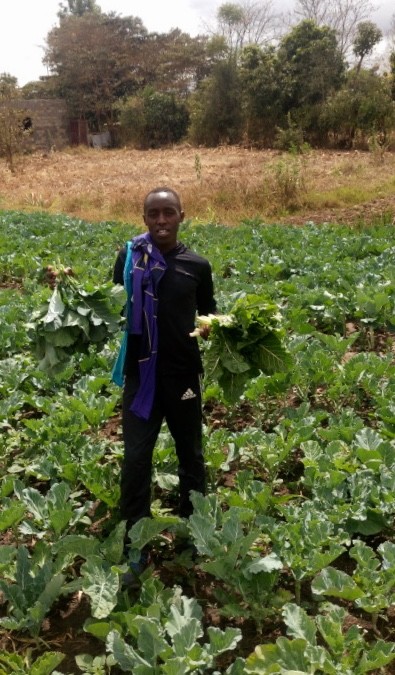
She ran and logged 151 miles in 44 days. Team members added this challenge to their existing goals and used the Challenge to further motivate them.
"Here are the special awards for our RTW Challenge 2 team," says Bob Anderson who reached 260.66 miles himself.
For Outstanding achievement: Frank Bozanich age 74 logged 801 miles...
Most Inspiring: Lize Dumon set her goal to reach 200 miles and she did that. She also motivated other team members in South Africa that she recruited to reach their goal as well...
Most Motivating: Aaron L. Salvador from the little country of Palau logged 377.99 miles, recruited others and posted a note and photo everyday...For
Best Performance: Willie Korir (second photo) from Kenya logged the most miles (993.88) which is an average of 22.5 miles per day. This is being shared with Joel Maina Mwangi also from Kenya who not only logged in 610.44 miles but he raced four half marathons during the Challenge period clocking 1:02:52, 1:03:19, 1:02:50 and 1:02:54...
Five Most Inspiring stories: based on their story posted on My Best Runs: (this award goes to the five who received the most views on My Best Runs) Joyce Lee (1178 views), Michael Wardian (851 views), Gloria Nasr (616 views), Joel Maina Mqangi (492 views), Pete Magill (400 views)...
Best Youngest performance: Zander Brister age 11 logged 16.32 miles. He ran one mile in Hollister clocking 6:19 and he also averaged 7:42/mile pace at the Pacific Grove Double Road Race 15k...
Best Oldest performance: Frank Bozanich age 74 logged 801 miles. Shared with 71-year-old Paul Shimon who logged 655.37 miles...
Top Fifteen Spirit awards: (Based on posts on the RTW Feed) Aaron L Salvador, Michael Anderson, Brent Weigner, Danilo Purlia, Larry Allen, Asya Cabral, Lize Dumon, Roger Wright, Geoffrey Smith, Carmen Gair, Annie Conneau, Joseph Brazil, Vince Martignetti, Marnie Margolis, Willie Korir...
Best Single Run: Michael Wardian when he ran 184.5 miles in 36 hours 48 minutes 14 seconds on the C&O Canal Trail...
Notable Mentions: Boaz Kipyego logged 788.61 miles and came to the United States and placed fourth at the Twin City Marathon. Rosaline Nyawira was first female logging 454.37 miles. Brent Weigner (69) has been running races every weekend including running a marathon in another country Sri Lanka. He logged 258 miles. James Kalani has gotten back into running (this challenge motivating him) and has already run 4 miles at 5:33 pace. He logged 252 miles.
Ultra marathon star Gloria Nasr from France logged 237 miles. Rosaura Tennant ran both the Berlin and Chicago marathon during this Challenge. Becca Pizzi was first woman in the marathon run inside a NFL stadium in Boston...
"Everyone is a winner on our team," says Bob Anderson. "I can't wait to do this again." RTW Challenge 3 start Oct 29.
Login to leave a comment
Run The World Global Run Challenge 1 July 4 Start Special Awards Announced
The Run The World Global Run Challenge 1 presented by My Best Runs started July 4, 2018. The goal was to run and log 24,901 Miles in the shortest posible time. "The mission was to celebrate running, motivate our team, inspire others and complete the challenge," says team caption Bob Anderson.
The team of 175 active runners finished in 36 Days 23 Hours and 13 Minutes on Thursday night August 9th at 11:13pm (PDT). "It was an amazing event and I can not wait until the next one starting August 29," says Geoff Smith (team member and two time Boston Marathon winner).
"Everyone on our team was a winner and deserve an award," says Bob Anderson. "Here are our special awards just announced today. Congrats to these winners and our entire team."
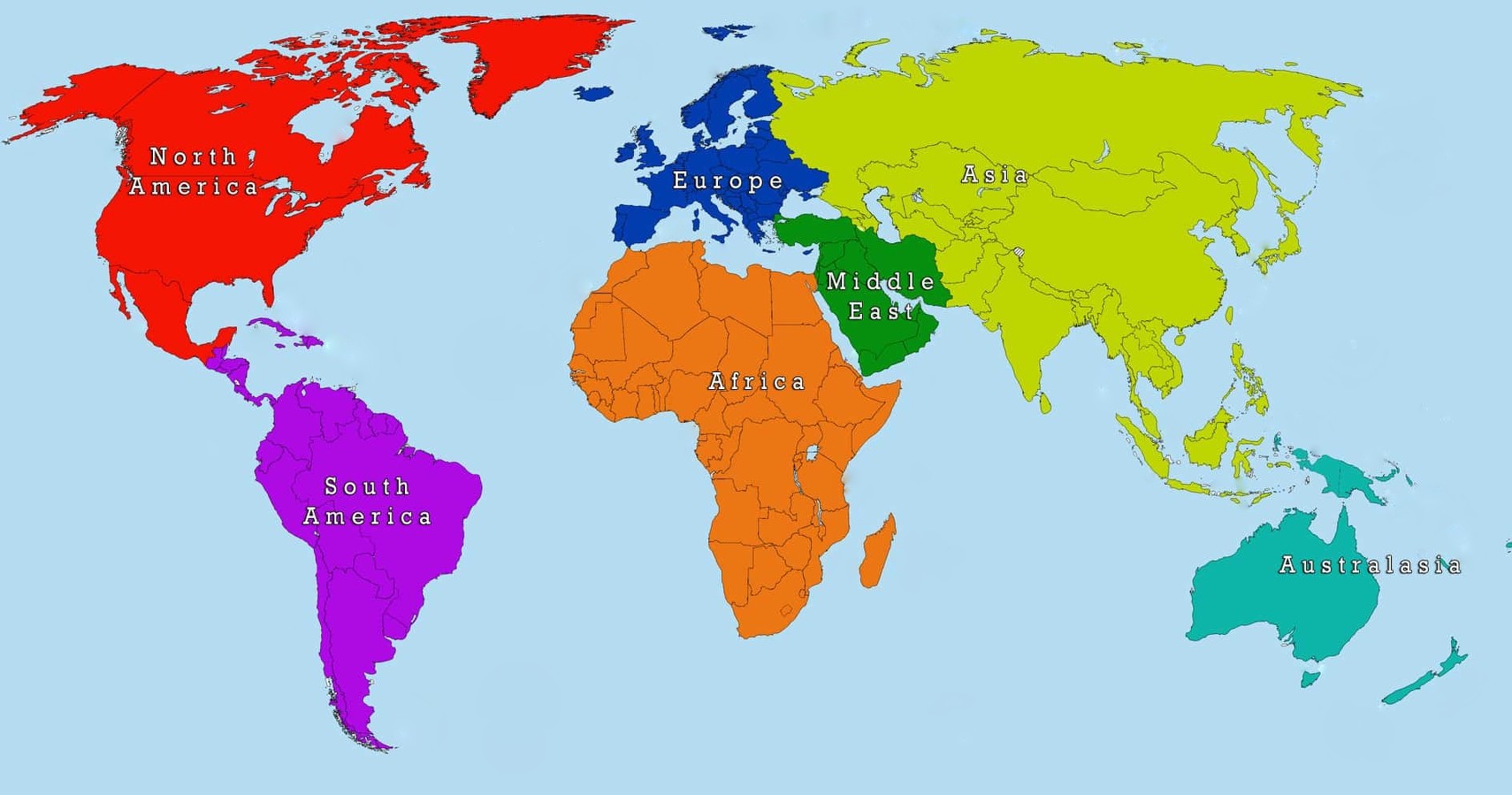
Outstanding achievement - Frank Bozanich age 74 logged 475 miles.
Most Inspiring - Aaron L. Salvador from the little country of Palau logged 296.4 miles and posted a comment and photo everyday. Shared with Geoff Smith who also posted a comment and photo everyday logged 240.5 miles (which is almost double what he was doing prior to the Challenge)
Most Motivating - Grace Padilla (US) logged 327.11 miles posted a comment and creative photo everyday. Grace who is 47 placed 11th overall and was first female.
Best Performance - Willie Korir from Kenya not only did he log the most miles (797.37) he also ran one of his workouts at 4:37/mile pace for 9.13 miles.
Five Most Inspiring stories - based on their story posted on My Best Runs: (this award goes to the five who received the most views on My Best Runs) Michael Wardian (1,677 views), Benn Griffin (1,461 views), Swetha Amit (1,431 views), Roy Pirrung (1,241 views) and Kiranpal Singh Dhody (1,088 views)
Most Inspiring Photo - Grace Padilla´s July 5th photo training on the track in Mammoth Lakes, California (featured photo).
Best Youngest performance - Owen Wall age 11 who logged 34.2 miles including running 8.1 miles in one day at 9:59 pace during his longest ever run. Shared with Elliot Daniels age 14 who ran and logged 184.45 miles and ran 5:47/mile pace for six miles in the Wharf to Wharf race in Santa Cruz, California.
Best Oldest performance - Libby James age 82 who logged 81.81 miles (rounds up to 82). Shared with 74-year-old Frank Bozanich who ran and logged in 475 miles.
Top Fifteen Spirit awards (based on coment and photo posted regularly that appeared on the Run The World Feed): Aaron L Salvador, Grace Padilla, Shawn Whalen, Michael Anderson, Brent Weigner, Danilo Purlia, Larry Allen, Rosaura Tennant, Asya Cabral, Kati Toivanen, Lize Dumon, Roger Wright, Abbey Cannon, Geoffrey Smith, and Pulkit Singh.
Best Single Run - Michael Wardian when we ran 100.5 miles in 30 hours 23 minutes to place 11th on July 21 at Hardrock 100.
Notable Mentions - Dave Mcgillivray logged 164.52 miles (Boston Marathon Director), Becca Pizzi logged 226.17 miles (Holds the record for running seven Marathons. Seven days on seven Continents), Liz Dumon had never run 150 Miles in 30 days before this challenge, Boaz Kipqego from Kenya logged 588.52 miles and placed second, JR Mintz (age 52) logged the most miles by an American with 480.86 miles, Paul Shimon (age 71) logged 390.71 miles placed 6th overall and was third American, Harpal Singh Gill was first runner from India logging 331.66 miles placing 10th overall, Sam Tada was first runner from Japan logging 237.30 miles placing 29th overall. Malin Andersson co-owner of World´s Marathons logged in 77.67 miles and Will Adams who logged 51.58 miles mostly all plogging (picking up trash while running).
Our next Run The World Global Run Challenge starts August 29. There is a $25 entry fee to help cover expenses unless you can not afford it and then it will be waived.
Login to leave a comment


